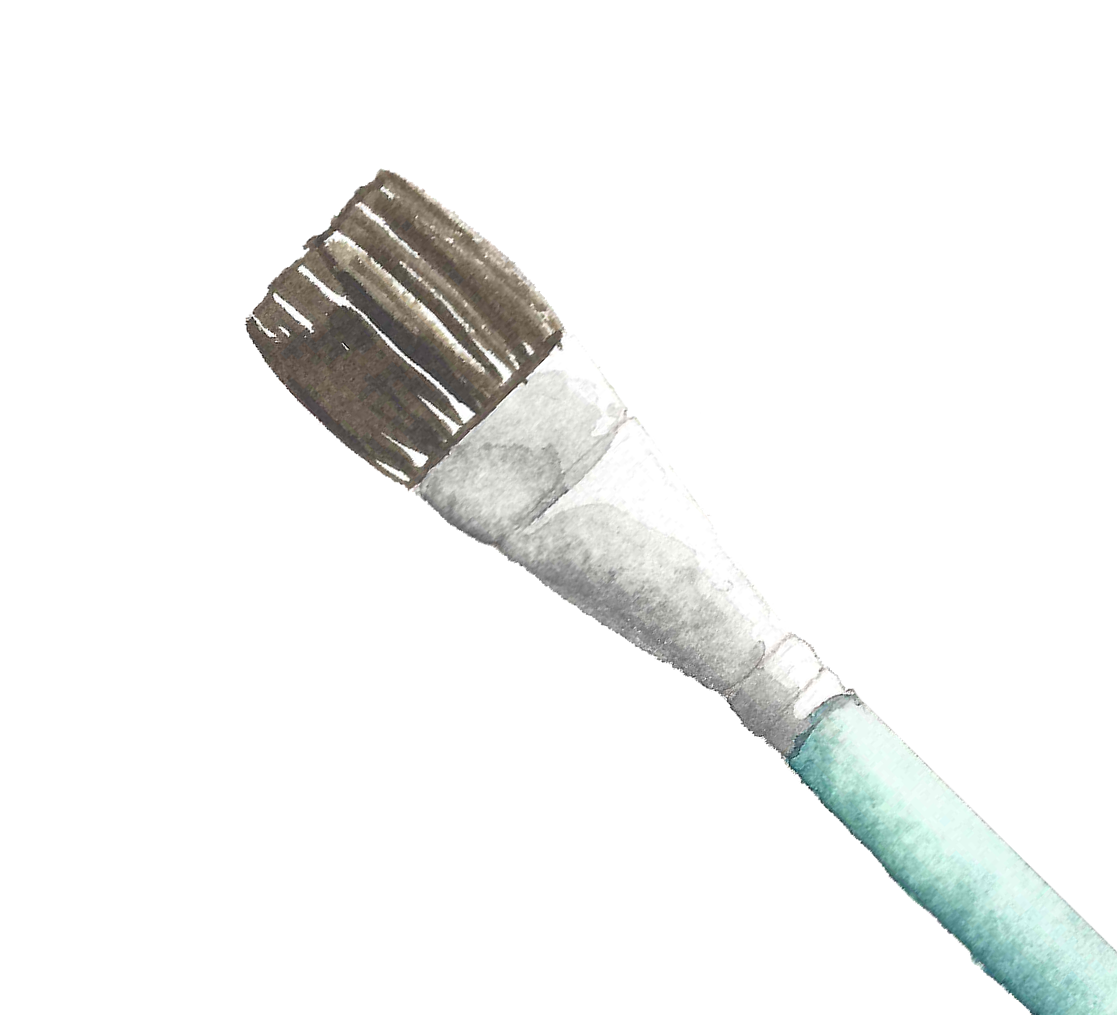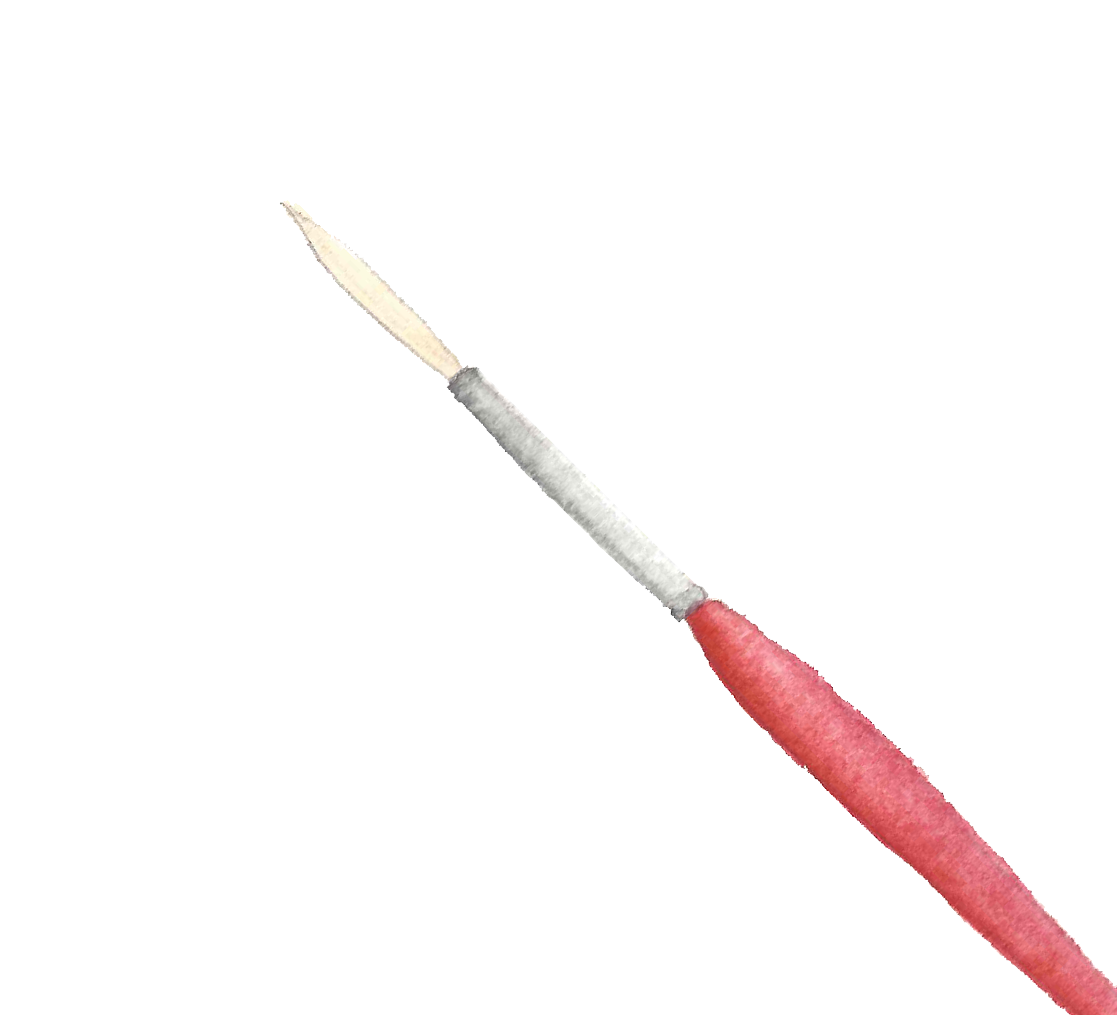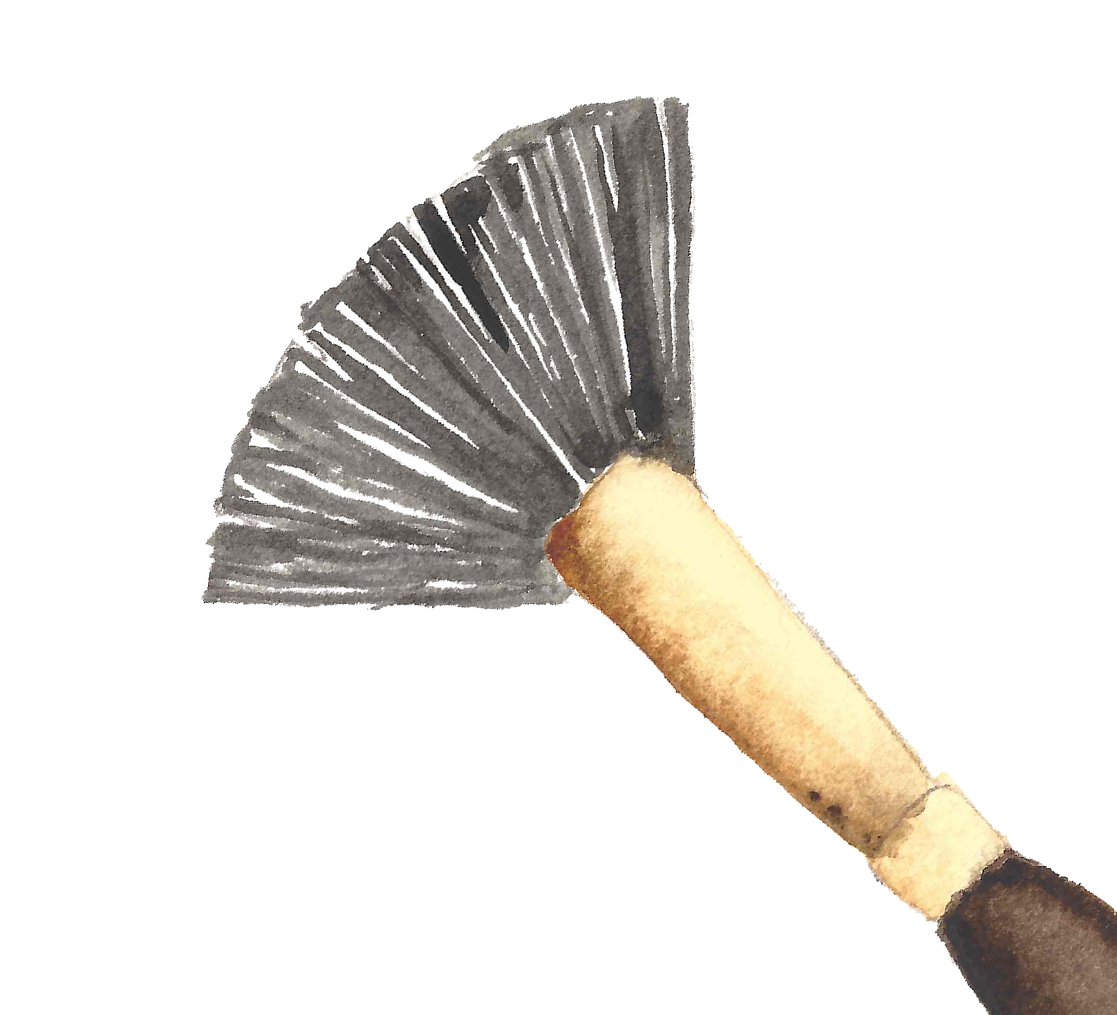What’s in the Box!? Types of Watercolor Paint Brushes
AN EASY GUIDE TO ESSENTIAL ART TOOLS
Paint Brush Anatomy | Paint Brush Types | Popular Brands | Paint Brush Tips
Welcome back to my official blog guide, “What’s in the Box!?”
And today we are going to approach the topic of watercolor paint brushes.
There are all kinds of brushes out there, and there are probably brushes that I didn’t get the chance to add to this list, but I hope to cover as much ground as I can to help you understand the world of watercolor paint brushes. I’ll be going over the more popular brushes and their purposes in today’s blog.
Let’s get to dispelling your paint brush curiosities!
TYPES OF PAINT BRUSHES
As I said earlier, not all paint brushes are made equally, and this is even more so for the different types of watercolor paint brushes that are available on the market today.
THE ROUND BRUSH
The most common, most versatile, and most commonly used paint brush in the world is the round brush; and you’ve most likely used one at some point in your life already. The round is, historically, the oldest type of brush to exist and until the metal ferrule was invented during the Industrial Revolution between 1760 and 1840 it was the only type of paint brush. Of course they came in all different sizes and designs depending on what part of the world you live in, but this innovation, the metal ferrule, is a relatively new one (which is a pattern we have repeatedly seen in some of our previous topics regarding the watercolor medium).
In some ways this is the only paint brush you really need although it is very convenient to have some other options on hand and it is really a lot of fun to explore other options. If you are a new to painting this is where you should start. I suggest staring with a brush size of 10 or 12 in your collection as you can achieve both great detail with its fine point and has a belly large enough to cary a relatively decent amount of paint. You can branch out to other sizes and types of brushes as you get more comfortable with the medium.
Especially small round brushes can be referred to as detail brushes as they are used to achieve particularly small details in paintings, or even in other applications like figurine or toy car replications.
SQUARE WASH
The second most common and most used paint brush is the Flat Wash which came about during the Industrial Revolution as I mentioned a moment ago. This invention was one of the more substantial changes made to brushes at the time and is obviously the forefather to some of the other paint brushes here on this list. This is the second brush that I suggest you add to your collection, but the size you get can depend on what you are trying to achieve with it. A larger 1 inch brush is a good place to start for larger washes, but having a smaller one on hand for smaller details can be helpful as well.
In watercolors the flat wash helps to square off areas in your painting, to get straight edges, and allows you to easily get into corners. This brush is especially useful when filling in backgrounds while also providing long or straight edges to your painting’s borders. I use this type of brush extensively when working on architecture because of the texture and appearance it adds to the painting. It provides a way to lay in blocks of color neatly in a row; meaning I can quickly and easily lay in brick work, paint vinyl siding on houses, or wooden fences and barns. They are also very handy when swatching your paints to get a nice even appearance. Trust me, with this brush in your arsenal you’ll find dozens of excuses to pull this one out.
MOTTLER
Mottler Brushes are similar to the Flat Wash brush, but these ones are larger, roughly measuring anywhere between one-half and two inches depending on where and why you are looking to purchase one. They are usually relatively short handled brushes, even more so than the average watercolor paint brush. This type of brush can provide a wide range of uses in the art world, but because we are talking about watercolors, let’s be a little more specific.
A good Mottler is going to be an extremely thirsty brush (meaning it can hold a lot of water) which can just as easily lay down large amounts of water or paint. The artist can apply large and even washes for the purpose of backgrounds, gradients, or really any other reason you might need for laying down large amounts of water or paint over a large area of canvas. They can also be used to help sweep up dust and whatnot off your canvas or work area, but for this I would suggest you keep a cheap one on hand for this purpose alone.
OVAL
An oval is a unique brush and really is a hybrid of both a flat and a round brush, giving you the delicate point and large belly of the round, and the ground-covering abilities of a flat wash. This can be considered to be a ‘Jack-of-all-trades’ paint brush.
I personally like using this paint brush when a larger area needs to be covered and you need a little bit of help getting into or around other areas in your painting. An example of this is filling in a background but you need to protect a bunch intricate details you must paint around in order to do so. You won’t necessarily get as clean and crisp an edge as the flat wash, and the size you buy can depend on how large your paintings are, so you can get a smaller one if your paintings tend to be on the small side and vice versa.
Dagger
I believe that the dagger, sometimes called a sword, is probably the most interesting brush on this list in my opinion, but possibly one of the most unrecognized of the bunch. It has a strange name, a strange shape, and it can be hard to imagine exactly what a brush like this could be used for. But it may turn out to be one of your favorite brushes to play around with once you actually get one in your hand because of how versatile it is.
The dagger’s primary purpose tends to be one stroke applications of paint for leaves, flowers, and just foliage in general. Its unique shape allows artists to easily replicate these types of strokes with no real fuss and it really prefers to be handled in this way. But that is not to say it is the only purpose because you can manage all types of organic, natural looking, or random brush strokes just by changing the way you hold it in your hand. I would be here forever if I explained every type of organic shape or foliage it lends itself towards, so just know that it can basically achieve almost any foliage or organic shape you could image and it does it with the flick of the wrist.
QUILL
On the other hand we have the paint brush known as the quill which is also sometimes called a mop brush, but I do believe that there is a difference between the two. The ferrule used on the quill is based on the old styles ferrule used before the metal ones were more widely implemented during the 19th century. These are instead made from plastic or other durable materials that get wrapped around the brush and is secured onto the bristles and handle with wire. Quills tend to be quite large and this type of fastening can be much more secure compared to other methods and is thus required for a brush of this size.
Keep in mind that this is not your typical round brush. It is much longer, wider, and has a much larger belly. These have their own measuring system as they can be larger than even the largest of round brushes. The actual sizing of this brush can vary so your best bet is to figure out what size you want in millimeters before making your final choice and adding that brush to your cart. This is a very thirsty brush and is perfect for larger sections of canvas to be covered relatively quickly with relative ease. You can potentially switch out your larger rounds or oval brush for this one and vice versa.
As I mentioned this brush is sometimes considered to be interchangeable with what is called a mop brush, but I do believe that there is a bit of difference. A big difference is that mops usually sport a metal ferrule, unlike the quill, and usually doesn’t come to as fine a point as the quill. Their purpose is not to paint small details, but instead they help to easily and quickly cover large areas. If you want a large brush that does come to a point however, the quill or oval are preferable.
SCRIPT
Script liner brushes, also known as a rigger, or fine liner brush, can be mistaken for a round but one can usually tell the difference between them due to the fact that these are much longer compared to their measured widths. These are intended for a number of purposes such as long, evenly withed lines but are also useful for grass, hair, tree branches, and, as the name implies, it can also handle script writing or calligraphy. This brush is also commonly used to add the artists signature to their finished paintings. They are useful because they hold a lot more paint than a similarly sized round brush allowing you to cover more ground in a single stroke.
You can potentially replace similarly sized detail or round brushes with a script liner as they will be able to achieve the same goals as a small round brush, but holds a lot more paint than their smaller counter parts. Some artists may find this more convenient as it means you don’t have to make as many trips back over to your palette while you are working on your painting. These brushes are often described as being able to absorb the shake some people have in their hands so that it doesn’t reach the paper, allowing people to get straighter lines than what they might be able to achieve with a detail or small round brush.
ANGLE
Here we have a play on the flat wash brush which gives us a brush that is longer to one side of the ferrule than the other. The angled brush is also very similar to the dagger and can be described as a shorter more controlled version of it. Of course the major difference being the amount of paint this brush can hold compared to the dagger, which means that the angle brush is going to have less of a belly.
This brush has a razor sharp edge so you can pull very fine lines or small details with it such as leaves with thorny-points. It can lay down long edges more easily and is a bit sharper than the flat wash when using the blade and can help you get into corners that are smaller than a 90* angle. It can achieve similar brush strokes compared to the dagger but they aren’t as free or organic or random as the dagger, as you might call it, making this brush is a bit more controlled. Some people use this brush for calligraphy as well because you can get both extremely thin and wide lines from the same brush (wide lines can be achieved when the brush is pulled to the side) creating the perfect combination of both worlds.
FILBERT
The filbert can be described as a variation of the flat wash except that this has a scalloped edge, and is longer than your typical flat wash. This can also have a sharp edge and its use is usually to pull a very specific shape, like those associated with flower petals or other similarly shaped curved edges. You can get various brush strokes from this brush by manipulating the way you hold it in your hand by twisting and/or pulling the brush along the paper. Filberts are an exceptional tool for when you need to paint circular shapes as the curved edges allow the paint brush to be pulled in a circular motion without going outside of the lines like a flat wash would.
FAN
Fan brushes are relatively well known, although I think this is simply because of its unique shape but I don’t know that most artists would actually know what to do with one if they did get their hands on it. For watercolor, it doesn’t necessarily meet the typical qualifications you would expect from a paint brush such as the capacity to hold a lot of water, there is not much belly to this brush so it runs out of paint rather quickly.
You can use this to your advantage however, by using it as a dry brush to get scattered textures. It can also be used to draw hair, grass, water, wood, and any other textures that might require either spaced out marks, or dry brush effects. Using it side to side can create some great ground textures, but you can also use it for tree leaves and tree trunk textures. You can also use this kind of brush for softening edges and to help blend them out.
TRAVEL
Travel brushes, also known as reversible, collapsable, or pocket brushes are really fun and interesting due to their unique design. These brushes are usually made of metal, some are partly made of plastic, and some do sport a bit of wood along the handle just below the ferrule.
They have a cap that goes over the bristles to protect them while in storage which helps to keep the bristles safe while they are banging around in your art bag. The fun part is that these covers can be turned around and attached to the bottom of the brush to extend it out further making it more comfortable to hold in your hand. The only thing to be said about this sort of brush is that it can be hard to find one that isn’t a round, although they do exist.
WATER BRUSH
Water brushes or brush pens are also are a type of travel brush and the difference being that they hold water in the body of the paint brush, so that it is easier to make art and paint while on the go. With the water in the body of the paint brush, it removes the need of a water cup which is much more convenient while on an air plane or train. It can be hard to find a convenient way to transport water and putting it in the handle of your brush saves space and time.
These paintbrush bristles are pretty much exclusively made from basic synthetic plastic materials, with no attempt to doup or replace a natural bristle. These paint brushes are usually inexpensive, and can differ greatly from brand to brand, so it is best that you try out a few styles to see what works best for you.
FIN
With all of that being said, I hope it is apparent that it is not necessary to have at least one of each and every brush on the list today. In fact, I am of the opinion that it is better to own as few brushes as you find necessary especially if you are just starting out on your watercolor journey. Start with a good round, and a good flat and you’ll be able to achieve most everything you’ll need to. Only when you start finding holes in the abilities of your brushes should you start expanding your collection as needed.
I’ll be talking about Popular Brush Brands in my next blog post so stick around for that!
That’s it for today, thanks for reading!
I’m MK and this is Draw Daily!













